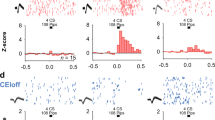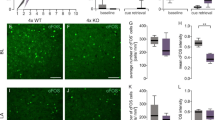Abstract
The canonical view on the central amygdala has evolved from a simple output station towards a highly organized microcircuitry, in which types of GABAergic neurons in centrolateral (CeL) and centromedial (CeM) subnuclei regulate fear expression and generalization. How these specific neuronal populations are connected to extra-amygdaloid target regions remains largely unknown. Here we show in mice that a subpopulation of GABAergic CeL and CeM neurons projects monosynaptically to brainstem neurons expressing neuropeptide S (NPS). The CeL neurons are PKCδ-negative and are activated during conditioned fear. During fear memory retrieval, the efficacy of this GABAergic influence on NPS neurons is enhanced. Moreover, a large proportion of these neurons (~50%) contain prodynorphin and somatostatin, two neuropeptides inhibiting NPS neurons. We conclude that CeL and CeM neurons inhibit NPS neurons in the brainstem by GABA release and that efficacy of this connection is strengthened upon fear memory retrieval. Thereby, this pathway provides a possible feedback mechanism between amygdala and brainstem routes involved in fear and stress coping.
Similar content being viewed by others
Log in or create a free account to read this content
Gain free access to this article, as well as selected content from this journal and more on nature.com
or
References
Carey AN, Lyons AM, Shay CF, Dunton O, McLaughlin JP (2009). Endogenous kappa opioid activation mediates stress-induced deficits in learning and memory. J Neurosci 29: 4293–4300.
Charney DS (2003). Neuroanatomical circuits modulating fear and anxiety behaviors. Acta Psychiatr Scand Suppl 108: 38–50.
Chauveau F, Lange MD, Jungling K, Lesting J, Seidenbecher T, Pape HC (2012). Prevention of stress-impaired fear extinction through neuropeptide s action in the lateral amygdala. Neuropsychopharmacology 37: 1588–1599.
Chessell IP, Black MD, Feniuk W, Humphrey PP (1996). Operational characteristics of somatostatin receptors mediating inhibitory actions on rat locus coeruleus neurones. Br J Pharmacol 117: 1673–1678.
Ciocchi S, Herry C, Grenier F, Wolff SB, Letzkus JJ, Vlachos I et al (2010). Encoding of conditioned fear in central amygdala inhibitory circuits. Nature 468: 277–282.
Deisseroth K, Bito H, Tsien RW (1996). Signaling from synapse to nucleus: postsynaptic CREB phosphorylation during multiple forms of hippocampal synaptic plasticity. Neuron 16: 89–101.
Dimitrov EL, Yanagawa Y, Usdin TB (2013). Forebrain GABAergic projections to locus coeruleus in mouse. J Comp Neurol 521: 2373–2397.
Donner J, Haapakoski R, Ezer S, Melen E, Pirkola S, Gratacos M et al (2010). Assessment of the neuropeptide S system in anxiety disorders. Biol Psychiatry 68: 474–483.
Douglass J, McKinzie AA, Pollock KM (1994). Identification of multiple DNA elements regulating basal and protein kinase A-induced transcriptional expression of the rat prodynorphin gene. Mol Endocrinol 8: 333–344.
Ebner K, Rjabokon A, Pape HC, Singewald N (2011). Increased in vivo release of neuropeptide S in the amygdala of freely moving rats after local depolarisation and emotional stress. Amino Acids 41: 991–996.
Fanselow MS (1980). Conditioned and unconditional components of post-shock freezing. Pavlov J Biol Sci 15: 177–182.
Hall J, Thomas KL, Everitt BJ (2001). Fear memory retrieval induces CREB phosphorylation and Fos expression within the amygdala. Eur J Neurosci 13: 1453–1458.
Han JH, Kushner SA, Yiu AP, Cole CJ, Matynia A, Brown RA et al (2007). Neuronal competition and selection during memory formation. Science 316: 457–460.
Haubensak W, Kunwar PS, Cai H, Ciocchi S, Wall NR, Ponnusamy R et al (2010). Genetic dissection of an amygdala microcircuit that gates conditioned fear. Nature 468: 270–276.
Hsiang HL, Epp JR, van den Oever MC, Yan C, Rashid AJ, Insel N et al (2014). Manipulating a "cocaine engram" in mice. J Neurosci 34: 14115–14127.
Itoi K, Sugimoto N (2010). The brainstem noradrenergic systems in stress, anxiety and depression. J Neuroendocrinol 22: 355–361.
Izumi T, Boku S, Shinmin W, Inoue T, Konno K, Yamaguchi T et al (2011). Retrieval of conditioned fear activates the basolateral and intercalated nucleus of amygdala. J Neurosci Res 89: 773–790.
Jungling K, Liu X, Lesting J, Coulon P, Sosulina L, Reinscheid RK et al (2012). Activation of neuropeptide S-expressing neurons in the locus coeruleus by corticotropin-releasing factor. J Physiol 590: 3701–3717.
Jungling K, Seidenbecher T, Sosulina L, Lesting J, Sangha S, Clark SD et al (2008). Neuropeptide S-mediated control of fear expression and extinction: role of intercalated GABAergic neurons in the amygdala. Neuron 59: 298–310.
Kluge C, Stoppel C, Szinyei C, Stork O, Pape HC (2008). Role of the somatostatin system in contextual fear memory and hippocampal synaptic plasticity. Learn Mem 15: 252–260.
Knoll AT, Carlezon WA Jr . (2009). Dynorphin, stress, and depression. Brain Res 1314: 56–73.
Land BB, Bruchas MR, Lemos JC, Xu M, Melief EJ, Chavkin C (2008). The dysphoric component of stress is encoded by activation of the dynorphin kappa-opioid system. J Neurosci 28: 407–414.
Laxmi TR, Stork O, Pape HC (2003). Generalisation of conditioned fear and its behavioural expression in mice. Behav Brain Res 145: 89–98.
Li H, Penzo MA, Taniguchi H, Kopec CD, Huang ZJ, Li B (2013). Experience-dependent modification of a central amygdala fear circuit. Nat Neurosci 16: 332–339.
Liu X, Zeng J, Zhou A, Theodorsson E, Fahrenkrug J, Reinscheid RK (2011). Molecular fingerprint of neuropeptide S-producing neurons in the mouse brain. J Comp Neurol 519: 1847–1866.
Mague SD, Pliakas AM, Todtenkopf MS, Tomasiewicz HC, Zhang Y, Stevens WC Jr . et al (2003). Antidepressant-like effects of kappa-opioid receptor antagonists in the forced swim test in rats. J Pharmacol Exp Ther 305: 323–330.
McLaughlin JP, Marton-Popovici M, Chavkin C (2003). Kappa opioid receptor antagonism and prodynorphin gene disruption block stress-induced behavioral responses. J Neurosci 23: 5674–5683.
Meis S, Bergado-Acosta JR, Yanagawa Y, Obata K, Stork O, Munsch T (2008). Identification of a neuropeptide S responsive circuitry shaping amygdala activity via the endopiriform nucleus. PLoS One 3: e2695.
Meis S, Sosulina L, Schulz S, Hollt V, Pape HC (2005). Mechanisms of somatostatin-evoked responses in neurons of the rat lateral amygdala. Eur J Neurosci 21: 755–762.
Meis S, Stork O, Munsch T (2011). Neuropeptide S-mediated facilitation of synaptic transmission enforces subthreshold theta oscillations within the lateral amygdala. PLoS One 6: e18020.
Okamura N, Garau C, Duangdao DM, Clark SD, Jungling K, Pape HC et al (2011). Neuropeptide S enhances memory during the consolidation phase and interacts with noradrenergic systems in the brain. Neuropsychopharmacology 36: 744–752.
Pare D, Quirk GJ, Ledoux JE (2004). New vistas on amygdala networks in conditioned fear. J Neurophysiol 92: 1–9.
Penzo MA, Robert V, Li B (2014). Fear conditioning potentiates synaptic transmission onto long-range projection neurons in the lateral subdivision of central amygdala. J Neurosci 34: 2432–2437.
Petrella C, Agostini S, Guerrini R, Calo G, Giaquinto A, De Nuccio C et al (2011). Neuropeptide S inhibits stress-stimulated faecal output in the rat. Pharmacol Res 64: 471–477.
Petrovich GD, Canteras NS, Swanson LW (2001). Combinatorial amygdalar inputs to hippocampal domains and hypothalamic behavior systems. Brain Res Brain Res Rev 38: 247–289.
Reinscheid RK (2008). Neuropeptide S: anatomy, pharmacology, genetics and physiological functions. Results Probl Cell Differ 46: 145–158.
Reinscheid RK, Xu YL, Civelli O (2005). Neuropeptide S: a new player in the modulation of arousal and anxiety. Mol Interv 5: 42–46.
Reyes BA, Carvalho AF, Vakharia K, Van Bockstaele EJ (2011). Amygdalar peptidergic circuits regulating noradrenergic locus coeruleus neurons: linking limbic and arousal centers. Exp Neurol 230: 96–105.
Reyes BA, Drolet G, Van Bockstaele EJ (2008). Dynorphin and stress-related peptides in rat locus coeruleus: contribution of amygdalar efferents. J Comp Neurol 508: 663–675.
Reyes BA, Johnson AD, Glaser JD, Commons KG, Van Bockstaele EJ (2007). Dynorphin-containing axons directly innervate noradrenergic neurons in the rat nucleus locus coeruleus. Neuroscience 145: 1077–1086.
Sangha S, Ilenseer J, Sosulina L, Lesting J, Pape HC (2012). Differential regulation of glutamic acid decarboxylase gene expression after extinction of a recent memory vs. intermediate memory. Learn Mem 19: 194–200.
Sara SJ (2009). The locus coeruleus and noradrenergic modulation of cognition. Nat Rev Neurosci 10: 211–223.
Sargin D, Mercaldo V, Yiu AP, Higgs G, Han JH, Frankland PW et al (2013). CREB regulates spine density of lateral amygdala neurons: implications for memory allocation. Front Behav Neurosci 7: 209.
Seidenbecher T, Laxmi TR, Stork O, Pape HC (2003). Amygdalar and hippocampal theta rhythm synchronization during fear memory retrieval. Science 301: 846–850.
Tye KM, Prakash R, Kim SY, Fenno LE, Grosenick L, Zarabi H et al (2011). Amygdala circuitry mediating reversible and bidirectional control of anxiety. Nature 471: 358–362.
Viviani D, Charlet A, van den Burg E, Robinet C, Hurni N, Abatis M et al (2011). Oxytocin selectively gates fear responses through distinct outputs from the central amygdala. Science 333: 104–107.
Xu YL, Reinscheid RK, Huitron-Resendiz S, Clark SD, Wang Z, Lin SH et al (2004). Neuropeptide S: a neuropeptide promoting arousal and anxiolytic-like effects. Neuron 43: 487–497.
Acknowledgements
We thank Julia Schröer, Elke Naß, Petra Berenbrock, Birgit Herrenpoth, Angelika Klinge, and Svetlana Kiesling for excellent technical assistance. We thank Dr Philippe Coulon for critical reading of the manuscript. Transgenic NPS-EGFP mice were a kind gift of Professor Rainer Reinscheid (University of California, Irvine, CA, USA).
Author Contributions
All experiments were performed at the Institute of Physiology I, Westfälische Wilhelms-Universität at Münster, Germany, and at the Department of Neurology, University Medicine Göttingen, Center Nanoscale Microscopy and Physiology of the Brain (CNMPB), Göttingen, Germany. Concept and design of the experiments: KJ, H-CP, with contributions from MDL, HJS, and JL. Collection, analysis and interpretation of data: all authors. Writing the article: KJ and H-CP, with contributions from HJS, JL, FSE, SK. All authors approved the final version of the manuscript.
Author information
Authors and Affiliations
Corresponding authors
Additional information
Supplementary Information accompanies the paper on the Neuropsychopharmacology website
Supplementary information
Rights and permissions
About this article
Cite this article
Jüngling, K., Lange, M., Szkudlarek, H. et al. Increased GABAergic Efficacy of Central Amygdala Projections to Neuropeptide S Neurons in the Brainstem During Fear Memory Retrieval. Neuropsychopharmacol 40, 2753–2763 (2015). https://doi.org/10.1038/npp.2015.125
Received:
Revised:
Accepted:
Published:
Issue date:
DOI: https://doi.org/10.1038/npp.2015.125
This article is cited by
-
The amygdala modulates prepulse inhibition of the auditory startle reflex through excitatory inputs to the caudal pontine reticular nucleus
BMC Biology (2021)
-
Sex differences in fear memory consolidation via Tac2 signaling in mice
Nature Communications (2021)
-
Neuroimaging in Narcolepsy and Idiopathic Hypersomnia: from Neural Correlates to Clinical Practice
Current Sleep Medicine Reports (2020)
-
Brain neuropeptide S: via GPCR activation to a powerful neuromodulator of socio-emotional behaviors
Cell and Tissue Research (2019)
-
Neuropeptide S Induces Acute Anxiolysis by Phospholipase C-Dependent Signaling within the Medial Amygdala
Neuropsychopharmacology (2018)



